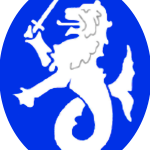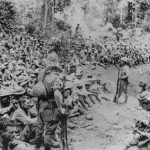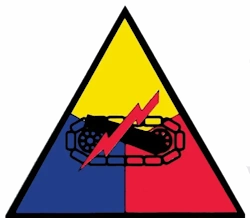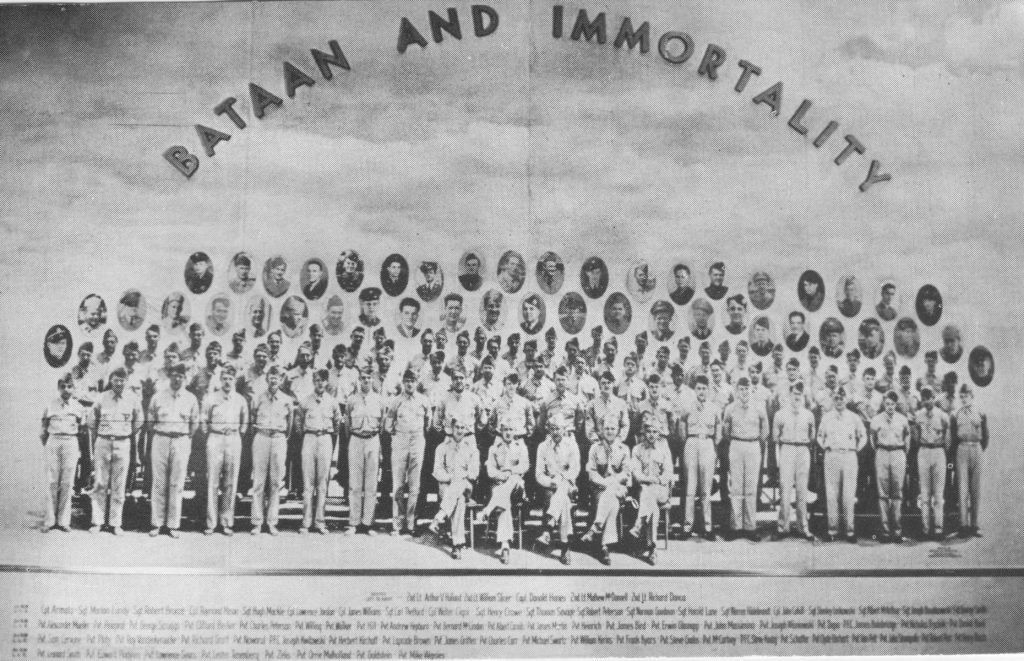Lt. Col. Wickord’s collection of POW drawings, including his own.
Click an image below to learn more.

Front view of a POW barracks at Ofuna Camp which was a interrogation camp in Japan. The buildings were made from scrap wood and put together in prefabricated 3 foot by 6 foot sections. There were 30, 6 foot by 9 foot, cells and each had wooden barred windows. The buildings were braced by wire to stakes and were very cold and dirty when windy. All the Drawings are Courtesy of Ted Wickord Jr.
Ofuna Camp Building

Rear view of Ofuna Camp in 1942. On left is the galley, on right is the benjo, and the area in the foreground was where most of the "formal" beatings took place. The picture was drawn from memory after the POW was sent to another camp where it was safer to draw.
Rear view Ofuna Camp

POW courtyard at Zentsuji where POWs hung bedding and clothing. The two buildings on the right were benjos. At first, the trip to the benjos was hazardous because of the human waste near them. After the POW dysentery was brought under control, it was much easier.
POW courtyard Zentsuji

POWs working outside the camp, at Zentsuji, smoking while on the work detail. The Japanese called these breaks "Smokoos."
Smokoo

POWs sunning themselves. The pipe, in the drawing, is a drain pipe, not a pipe to heat the barracks. The food drying on the window sill is a POW delicacy called Hoshi Cake which was made Japanese medical pills, water, and some flavoring if it was available.
POWs sunning themselves.

Each Sunday night at Zentsuji, the POWs put on a show of singing, acting, and costumes.
Sunday night show

Each barracks at Zentsuji was referred to as a room. This drawing is of Room 18 which was where Lt. Col. Ted Wickord lived in the camp.
Lt. Wickord's room at Zentsuji.

Two POWs at Zentsuji Camp on night "Death Watch" in the camp bathhouse which had a concrete floor. One reason this was done was to prevent the rats from chewing on the body.
Zentsuji death watch

Birthday card given to Lt. Col. Ted Wickord by the officers the 192nd Tank Battalion who were POWs with him at Zentsuji POW Camp. Donald Duck was a nickname given to a guard at Cabanatuan.
Wickord Birthday card

Signatures of the officers, of the 192nd Tank Battalion Officers, on the birthday card, who were with Lt. Col. Ted Wickord at Zentsuji POW Camp.
Signatures of the officers, of the 192nd Tank Battalion

POW at Zentsuji performing outside cleanup. The brooms were made from hard twigs that fell apart in heavy use. The cart, in the background, held 8 barrows for benjo cleaning.
POW at Zentsuji performing outside cleanup. The brooms were made from hard twigs that fell apart in heavy use. The cart, in the background, held 8 barrows for benjo cleaning.

At some point, every POW at Zentsuji had to work the detail that cleaned out the Benjo at Zentsuji. The POWs with the duty were called "Benjo Dippers."
At some point, every POW at Zentsuji had to work the detail that cleaned out the Benjo at Zentsuji. The POWs with the duty were called "Benjo Dippers."

POWs in Room 15 working on an indoor stove, at Zentsuji, made from Red Cross cans and a rubbing compound - given to the POWs by the Japanese - called "mentholatum" as the heating element. The heaters were against all rules and fire hazards. When an officer was caught using one he was either slapped around or put in the solitary in the camp's "Aso." The Japanese guard, partially turned around, smells something but does not see the cause of the smell. This drawing is based on a true incident.
POWs in Room 15 working on an indoor stove, at Zentsuji, made from Red Cross cans and a rubbing compound - given to the POWs by the Japanese - called "mentholatum" as the heating element. The heaters were against all rules and fire hazards. When an officer was caught using one he was either slapped around or put in the solitary in the camp's "Aso." The Japanese guard, partially turned around, smells something but does not see the cause of the smell. This drawing is based on a true incident.

POWs at Zentsuji clean their barracks. The dust created during the clean up was a major problem. In the background in the cabinet, over the table, holds dishes for soup, rice, and tea.
POWs at Zentsuji clean their barracks. The dust created during the clean up was a major problem. In the background in the cabinet, over the table, holds dishes for soup, rice, and tea.

A regular event in the barracks was what the POWs referred to as "The Flea Hunt."
A regular event in the barracks was what the POWs referred to as "The Flea Hunt."

The galley showing soup pots and rice pots in the background. The Japanese guard in the foreground is measuring out soup ration of pickled dikons down to the last ounce.
The galley showing soup pots and rice pots in the background. The Japanese guard in the foreground is measuring out soup ration of pickled dikons down to the last ounce.

POWs awaiting their tea which like everything else was rationed to the POWs. Tea time was immediately after morning tinko at 7:30 A.M., again at 9:30 A.M., 1:30 P.M., and possibly at 5:30 P.M. There were 32 cups of tea to a pot, and each POW received a second issuance every fourth time if water was available and not needed for soup.
POWs awaiting their tea which like everything else was rationed to the POWs. Tea time was immediately after morning tinko at 7:30 A.M., again at 9:30 A.M., 1:30 P.M., and possibly at 5:30 P.M. There were 32 cups of tea to a pot, and each POW received a second issuance every fourth time if water was available and not needed for soup.

Officers carrying rocks from the fields to camp for roads and paths
Officers carrying rocks from the fields to camp for roads and paths

Looking down on the camp vegetable project with the camp is in the background. Mounds in the center were made from surface topsoil cut out in strips to get at the soil below.
Looking down on the camp vegetable project with the camp is in the background. Mounds in the center were made from surface topsoil cut out in strips to get at the soil below.

POWs take a ten minute break while working for a smoke. They received one break per hour. During that time they shot the bull, talked of food, or talked of new recipes.
POWs take a ten minute break while working for a smoke. They received one break per hour. During that time they shot the bull, talked of food, or talked of new recipes.

2nd Lt. Henry G. "Spider" Webb, U.S.M.C., sunning himself and reading of Room 9. The tree in the background was pruned under the direction of a Japanese doctor.
2nd Lt. Henry G. "Spider" Webb, U.S.M.C., sunning himself and reading of Room 9. The tree in the background was pruned under the direction of a Japanese doctor.

Garden plots at Zentsuji were across from the barracks. The gardens were planted to produce crops the year round. When one crop was harvested, another went in within a week. Crops grown by the POWs were: eggplant, daikons, leeks, onions, squash, string beans, cucumbers, tomatoes, and takana ( a form of spinach). The building in the foreground was POW housing while the building further back contained camp offices, conference rooms, storerooms, as well as housing for 225 POWs.
Garden plots at Zentsuji were across from the barracks. The gardens were planted to produce crops the year round. When one crop was harvested, another went in within a week. Crops grown by the POWs were: eggplant, daikons, leeks, onions, squash, string beans, cucumbers, tomatoes, and takana ( a form of spinach). The building in the foreground was POW housing while the building further back contained camp offices, conference rooms, storerooms, as well as housing for 225 POWs.

POW sitting on the end of his bunk reading. Note seat pads, blankets with pillows, red cross boxes on a shelf with personal effects all in the prescribed order given by the Japanese.
POW sitting on the end of his bunk reading. Note seat pads, blankets with pillows, red cross boxes on a shelf with personal effects all in the prescribed order given by the Japanese.

Scene in barracks after issuance of Red Cross boxes. The lucky POW was the man who got a 7 Camel 4 Butter box. All foodstuffs soon picked up a value relative to some other item in the box with a can a butter usually being the usual unit of exchange. Typical trade; 3 butter/1 Klim, 2 butter/1 cheese, 1½ butter/1coffee, 1 butter/3 to 7 packs of cigarettes (Camel's preferred).
Scene in barracks after issuance of Red Cross boxes. The lucky POW was the man who got a 7 Camel 4 Butter box. All foodstuffs soon picked up a value relative to some other item in the box with a can a butter usually being the usual unit of exchange. Typical trade; 3 butter/1 Klim, 2 butter/1 cheese, 1½ butter/1coffee, 1 butter/3 to 7 packs of cigarettes (Camel's preferred).

Christmas Card given to Lt. Col. Ted Wickord, in 1944, that references to the fact he led the effort to raise rabbits to provide meat in the POWs' meals
Christmas Card given to Lt. Col. Ted Wickord, in 1944, that references to the fact he led the effort to raise rabbits to provide meat in the POWs' meals

POWs practicing loading their possessions and carrying them as they prepare to be transferred from Zentsuji POW Camp to Rokuroshi POW Camp
POWs practicing loading their possessions and carrying them as they prepare to be transferred from Zentsuji POW Camp to Rokuroshi POW Camp

POWs forming ranks as they prepare to leave Zentsuji and march to the train station.
POWs forming ranks as they prepare to leave Zentsuji and march to the train station.

POWs waiting in the Okiyama Railroad Station during the transfer from Zentsuji to Rokuroshi.
The caption was, "Rain outside, B-29s in the area, fleas all over, and the benjo an hour wait in line."
POWs waiting in the Okiyama Railroad Station during the transfer from Zentsuji to Rokuroshi.
The caption was, "Rain outside, B-29s in the area, fleas all over, and the benjo an hour wait in line."

POWs on train from Okayama, Japan to Osaka, Japan in June 1945.
POWs on train from Okayama, Japan to Osaka, Japan in June 1945.

POWs hiking, in a drizzle, to Rokuroshi, after the train ride from Zentsuji, from 9:00 P.M. to 1:30 A.M., in June 1945. Lt. Col. Ted Wickord described it as a miserable wet hike, over mountains, without lights. The POW on the crutches is 2nd Lt. Fred Garrett. and the POW with his legs spread as he walked was 2nd Lt. Bob Russell who had beriberi.
POWs hiking, in a drizzle, to Rokuroshi, after the train ride from Zentsuji, from 9:00 P.M. to 1:30 A.M., in June 1945. Lt. Col. Ted Wickord described it as a miserable wet hike, over mountains, without lights. The POW on the crutches is 2nd Lt. Fred Garrett. and the POW with his legs spread as he walked was 2nd Lt. Bob Russell who had beriberi.

POW Barracks at Rokuroshi. The POWs carried cut trees for the camp fence and carried them to the camp which are seen lying on the ground in the drawing.
POW Barracks at Rokuroshi. The POWs carried cut trees for the camp fence and carried them to the camp which are seen lying on the ground in the drawing.

Top level of the bunks used by POWs at Rokuroshi. The POWs arrived in June 1945 and found, with the sun beating in, that the top bunks were extremely hot. Cleaning them was also a problem because the dirt would fall on the men and bunks below them
Top level of the bunks used by POWs at Rokuroshi. The POWs arrived in June 1945 and found, with the sun beating in, that the top bunks were extremely hot. Cleaning them was also a problem because the dirt would fall on the men and bunks below them

Lt. Col. Ted Wickord's view of the POW barracks at Rokuroshi. Since they arrived in June 1945, the heat was one of the major problems the men POWs had to deal with.
Lt. Col. Ted Wickord's view of the POW barracks at Rokuroshi. Since they arrived in June 1945, the heat was one of the major problems the men POWs had to deal with.

Drawing, by 1st Lt. Robert Studer, showing POWs asking one of the "artists," at Rokuroshi, to draw them anniversary, Christmas, wedding and birthday cards.
Drawing, by 1st Lt. Robert Studer, showing POWs asking one of the "artists," at Rokuroshi, to draw them anniversary, Christmas, wedding and birthday cards.

POWs watch carefully as food is divided among them.
POWs watch carefully as food is divided among them.

One POW arguing with another that he should eat before the food is given to the pigs.
One POW arguing with another that he should eat before the food is given to the pigs.

POW receiving a haircut while another POW referred to as a "quanner" whips his food. A little hair in the food added protein.
POW receiving a haircut while another POW referred to as a "quanner" whips his food. A little hair in the food added protein.

POWs at Rokuroshi POW Camp practicing their art skills which allowed them to record life in the camps.
POWs at Rokuroshi POW Camp practicing their art skills which allowed them to record life in the camps.

A Japanese bakery and warehouse was located just outside Rokuroshi POW Camp. The smell of the food caused many POWs to attempt to raid the warehouse after lights were out to bring back sugar, salt, meats, vegetables, hardtack, fish, and canned goods. If caught, the penalty, after receiving a beating, was to be sent to a civilian POW camp
A Japanese bakery and warehouse was located just outside Rokuroshi POW Camp. The smell of the food caused many POWs to attempt to raid the warehouse after lights were out to bring back sugar, salt, meats, vegetables, hardtack, fish, and canned goods. If caught, the penalty, after receiving a beating, was to be sent to a civilian POW camp

Two POWs at Rokuroshi attempt to "Sweat Out" food from two Japanese guards as excess food is being to the galley for cleanup. Officers from all the Allied Countries took part in this practice.
Two POWs at Rokuroshi attempt to "Sweat Out" food from two Japanese guards as excess food is being to the galley for cleanup. Officers from all the Allied Countries took part in this practice.

In July 1945, there was finally enough hot water for the POWs to shower.
In July 1945, there was finally enough hot water for the POWs to shower.

POW getting a light from another POW since matches were at a premium.
POW getting a light from another POW since matches were at a premium.

When the POWs ran out of matches, the Japanese often refused to issue them more, so they turned to other methods of lighting a cigarette.
When the POWs ran out of matches, the Japanese often refused to issue them more, so they turned to other methods of lighting a cigarette.

Rice distribution. 20 men were fed from a bucket that was one quarter full.
Rice distribution. 20 men were fed from a bucket that was one quarter full.

Snakes caught and cooked in the bush added some protein to the POW diet. The POWs ate snakes, frogs, toads, hornets nests, and anything else to supplement their diet.
Snakes caught and cooked in the bush added some protein to the POW diet. The POWs ate snakes, frogs, toads, hornets nests, and anything else to supplement their diet.

Lt. John N. "Trurk" Critchlow, U.S.N., sunning himself.
Lt. John N. "Trurk" Critchlow, U.S.N., sunning himself.

POW reading on his bunk at Rokuroshi. Notice that his pants are tucked into his socks against fleas and other pests.
POW reading on his bunk at Rokuroshi. Notice that his pants are tucked into his socks against fleas and other pests.

On the right, a "go ahead," which was the most common form of footwear among the POWs. On the left a canvas overshoe for cold weather use. Both types were made by the POWs.
On the right, a "go ahead," which was the most common form of footwear among the POWs. On the left a canvas overshoe for cold weather use. Both types were made by the POWs.

"Go me benjo ka" or words similar to that. Security checking off men on the benjo run, at Rokuroshi, which was miserable and unnecessary job done by order of the camp commandant.
"Go me benjo ka" or words similar to that. Security checking off men on the benjo run, at Rokuroshi, which was miserable and unnecessary job done by order of the camp commandant.

Rokuroshi wash rack. A 1¼ water pipe with fluctuating water pressure was the sole supply of water in the camp for 360 men. Men on the left are lined up and waiting for a dribble of water to clean their mess kits. The racks were also used as laundry bins and as a vegetable cutting table.
Rokuroshi wash rack. A 1¼ water pipe with fluctuating water pressure was the sole supply of water in the camp for 360 men. Men on the left are lined up and waiting for a dribble of water to clean their mess kits. The racks were also used as laundry bins and as a vegetable cutting table.

A shim, plunger, and rice gun barrel in addition to the all-important paddle and spoon. A rice gun was one of the easiest and the fastest ways of insuring even distribution of rice.
A shim, plunger, and rice gun barrel in addition to the all-important paddle and spoon. A rice gun was one of the easiest and the fastest ways of insuring even distribution of rice.

One of the two daily musters for "tinko" being taken by a Japanese officer. The scale is correct and the proportion of sword to the man is correct. If a POW did not have his number tag on and around his neck, he was called to the office to explain where it is and why he did not have it on.
One of the two daily musters for "tinko" being taken by a Japanese officer. The scale is correct and the proportion of sword to the man is correct. If a POW did not have his number tag on and around his neck, he was called to the office to explain where it is and why he did not have it on.

The same POW going to the benjo the next day, but something is definitely different and he does not have to check in. The POWs don't want to put too much hope in rumors. The guards sat down and relaxed with the POWs and there were no airplanes overhead day or night. The food ration was not cut so the POWs knew something was up. They officially learned the war was over on August 22 at 3:57 in the afternoon.
The same POW going to the benjo the next day, but something is definitely different and he does not have to check in. The POWs don't want to put too much hope in rumors. The guards sat down and relaxed with the POWs and there were no airplanes overhead day or night. The food ration was not cut so the POWs knew something was up. They officially learned the war was over on August 22 at 3:57 in the afternoon.
























